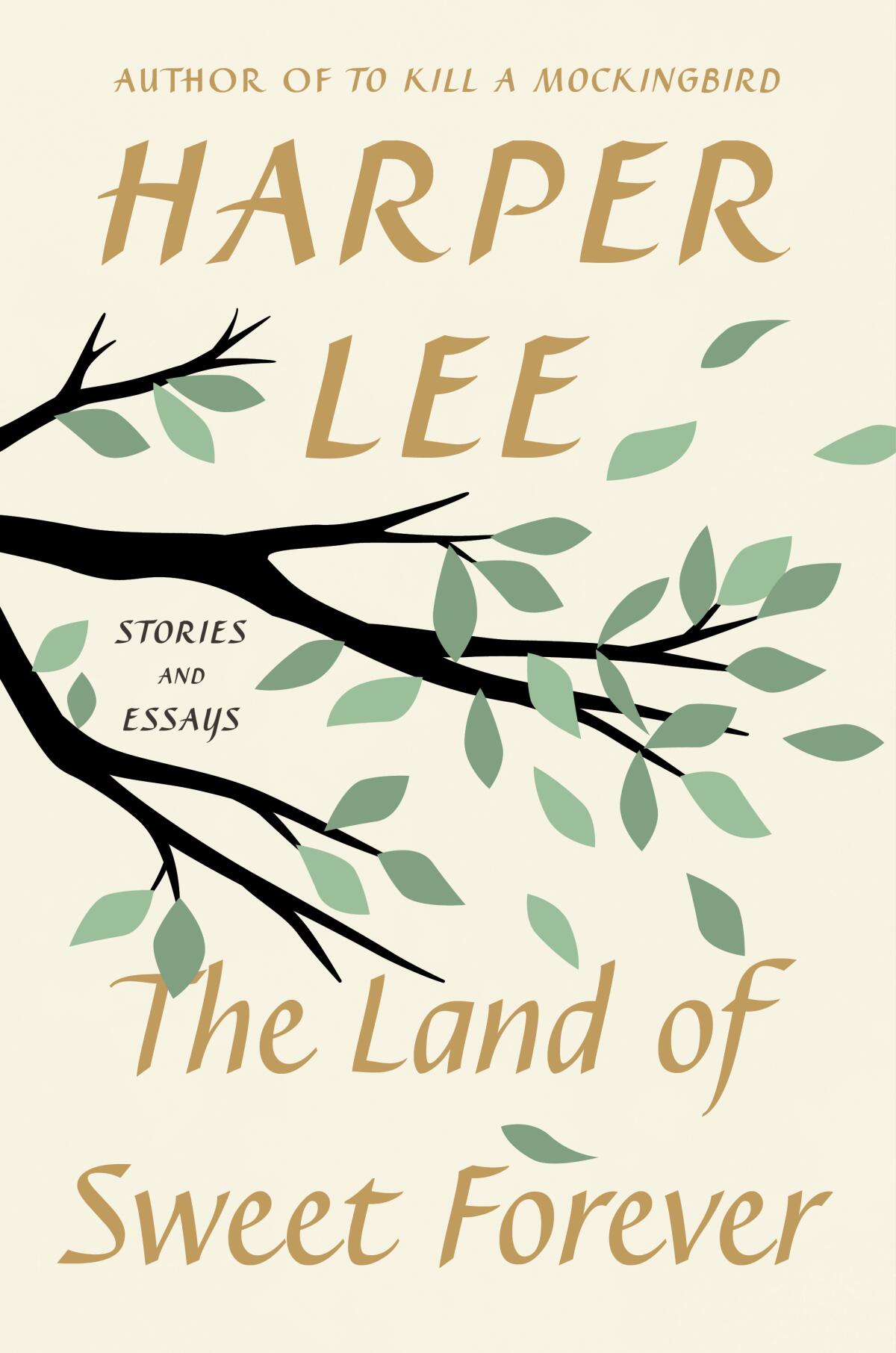Harper Lee’s ‘Land of Sweet Forever’ review: Collection adds to legacy
Book Review
The Land of Sweet Forever
By Harper Lee
Harper: 224 pages, $30
If you buy books linked on our site, The Times may earn a commission from Bookshop.org, whose fees support independent bookstores.Book Review
Fortunately for avid bibliophiles, Harper Lee was an inveterate pack rat. Born in rural Monroeville, Ala., in 1926, the author of “To Kill a Mockingbird” — whose first name is Nelle, her grandmother Ellen’s name spelled backward — spent much of her adult life in Manhattan after moving there in 1949.
First, she lived in a cold-water flat on the Upper East Side (subsisting on peanut butter sandwiches and meager bookstore and airline ticket agent salaries); then in a room in a Midtown hotel where Edith Wharton and Mark Twain once resided; a third-floor York Avenue walk-up ($20 a month for five years, where “Go Set a Watchman” and “To Kill a Mockingbird” were written); and, finally four decades at 433 E. 82nd St. There, amid “piles of her correspondence and practically every pay stub, telephone bill and canceled check ever issued to her, were notebooks and manuscripts” and eight previously unpublished early short stories and eight once-published essays and magazine articles. Those writings, discovered in her New York City apartment after she died in her Alabama hometown nine years ago, have been gathered into the welcome hybrid compendium “The Land of Sweet Forever.”

The short stories take up the first half of the collection, but it’s an unusual selection in the second half, “Essays and Miscellaneous Pieces,” that may reveal as much about the burgeoning author as the fictional juvenilia. In a contribution to “The Artists’ & Writers’ Cookbook” (1961), along with entries by Lillian Hellman, William Styron and Marianne Moore, Lee offered a one-page recipe for crackling bread, complete with the authorial observation, “some historians say by which alone fell the Confederacy.” The opening instruction is, “First, catch your pig.” After that, the ingredients (water-ground white meal, salt, baking powder, egg, milk) and directions might just as well function as an analogy for the process of writing and editing a manuscript.
In her introduction, Lee’s appointed biographer Casey Cep observes that it “takes enormous patience and unerring instincts to refine a scrap of story into something … keen and moving.” Lee admits to being “more of a rewriter than a writer.” In a 1950 letter to one of her sisters, she outlines her typical writing day, working through at least three drafts:
From around noon, work on the first draft. By dinnertime, I’ve usually put my idea down. I then stop for a sandwich or a full meal, depending on whether I’ve got to think more about the story or just finish it. After dinner, I work on a second draft, which involves sometimes tearing the story up and putting it together again in an entirely different way, or just keeping at it until everything is like I want it. Then I retype it on white paper, conforming to rules of manuscript preparation, and run out & mail it. That sounds simple, but sometimes I have worked through the night on one; usually I end up around two or three in the morning.
It’s all rather like testing, perfecting a recipe. If the product was these eight short stories, then “yes, chef” has baked a perfect loaf.
Each story illuminates Lee’s quintessential talents as the “balladeer of small-town culture” and the chronicler of city life. They display narrative skills, an acute ear for dialogue (especially the vernacular), development of fully rounded characters and vivid descriptions of settings. They also introduce subjects and significant themes — family, friendship, moral compass — that reappear in her nonfiction and novels.
Country life imposes restrictions on childhood characters in the first three stories. In “The Water Tank” anxious 12-year-old Abby Henderson, reacting to schoolyard rumors, believes she’s pregnant because she hugged a boy whose pants were unbuttoned. Anti-authoritarian first grader Dody (one of Harper’s nicknames) in “The Binoculars” is chastised for not tracing but writing her name on the blackboard. Early glimpses of “Mockingbird’s” Scout and Atticus Finch appear in the amusing “The Pinking Shears” when third grader “little Jean Louie” (without the later “s”) undermines gender rules when she whacks off a rambunctious minister’s daughter’s lengthy locks.
In New York City, where “sooner or later you meet everybody you ever knew on Fifth Avenue,” urban stress leads to a shocking monologue with an incendiary conclusion about feuding neighbors in “A Roomful of Kibble,” a frivolous kind of parlor game involving movie titles in “The Viewer and the Viewed,” and a humorous parking incident when one friend agrees to help another with lighting for a fashion show in “This Is Show Business?”
The closing title short story, “The Land of Sweet Forever,” adeptly merges locations and themes. It opens with a satirical nod to Jane Austen’s “Pride and Prejudice”: “It is a truth generally acknowledged by the citizens of Maycomb, Ala., that a single woman in possession of little else but a good knowledge of English social history must be in want of someone to talk to.” When adult Jean Louise (now with the “s”) leaves the city for home, she has a hilarious church encounter with someone she hadn’t seen since they were children, 21-year-old Talbert Wade, now with the taint of three years as an economics major at Northwestern University and a patina full of Europe, looking “suspiciously as if he had returned from a tour and had picked up a Brooks Brothers suit on the way home.” Together, they are trying to understand why the doxology, always sung “in one way and one way only” suddenly has been “pepped up” with an energetic organ accompaniment. Before it’s resolved there is an amusing anecdote about a cow obituary in verse and a concluding bow to Voltaire’s “Candide” when Jean Louise concedes that “all things happen for the best in this, the best of all possible worlds.” The story is a resounding example of Lee’s scintillating sense of wry humor.
Big themes of love, family and friendship recur in the eight previously published essays and articles (from 1961 to 2006) that appeared in Vogue, McCall’s, an American Film Institute program (about Gregory Peck), a Book of the Month Club newsletter (on the “little boy next door” Truman Capote and “In Cold Blood”), Alabama History and Heritage Festival, and O, the Oprah Magazine (a letter about the joy of learning to read). In addition to the crackling bread recipe that serves as a fingerpost to Lee’s writing process, the standout essay “Christmas to Me” details how she received a generous gift that changed her life, allowing her to become an accomplished, published writer. In 1956, best friends, lyricist-composer Michael Brown and his wife, Joy, surprised her with an envelope on the tree with a note, “You have one year off from your job to write whatever you please. Merry Christmas.” That meant $100 every month, covering more than five times her rent.
Juvenilia is tricky. It can be evanescent, exposing weaknesses or revealing strengths and talent. “The Land of Sweet Forever” reinforces Lee’s indelible voice, contributing a rewarding addition and resource to the slim canon of her literary legacy.
The recipe for crackling bread:
First, catch your pig. Then ship it to the abattoir nearest you. Bake what they send back. Remove the solid fat and throw the rest away. Fry fat, drain off liquid grease, and combine the residue (called “cracklings”) with:
1 ½ cups water-ground white meal
1 teaspoon salt
1 teaspoon baking powder
1 egg
1 cup milk
Bake in very hot oven until brown (about 15 minutes).
Result: one pan crackling bread serving 6. Total cost: about $250, depending upon size of pig. Some historians say by this recipe alone fell the Confederacy.
Papinchak, a former English professor, is a freelance book critic in Los Angeles. He has also contributed interviews to Bon Appetit.



